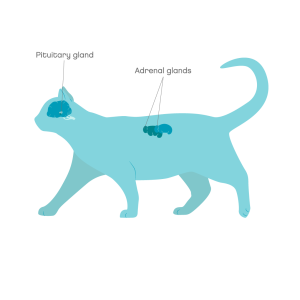Cushing’s syndrome in cats is a disease caused by excess levels of the hormone cortisol. It is very rare in cats. It affects many organs and body functions and, in some cases, can be due to cancer.
Cushing’s syndrome, or hyperadrenocorticism, happens when the adrenal glands produce too much cortisol. This disrupts normal metabolism and causes many problems, such as an increased risk of infections and diabetes. Treatments are available, but most cats have other conditions at the same time, and they often do not do well.
A similar disease can happen in cats that have been on treatment with very high doses of steroids for a long time, but this can be solved by slowly reducing the treatment dose. This must always be done under close monitoring by a vet.
Overview
What is Cushing’s syndrome in cats?
Cushing’s syndrome is a disease caused by a growth or cyst in one of two organs, the pituitary gland near the brain or the adrenal glands near the kidneys. This growth can sometimes be cancerous.
90% of cats will also have diabetes, and many have kidney or heart disease.
Affects middle-aged and older cats. This is a serious and life-long condition.

Symptoms
Symptoms of Cushing’s syndrome
Symptoms of Cushing’s disease are varied due to the effects of the hormone on many organs.
Excessive drinking and urination are very common, this may lead to toileting accidents in the house.
Increased appetite is very common.
Hair loss and repeated skin infections are frequent, the skin can be easily injured or even torn.
Muscles can become weaker and exercising difficult.
Respiratory infections happen easily and can be difficult to treat.
Increased sexual behaviour may be noted.
Changes in general behaviour or seizures can happen if the brain becomes affected.
Risk
Are some cats at higher risk than others?
There are no known breed or sex risk factors.
This disease happens in middle-aged and older cats.
Diagnosis
How is Cushing’s syndrome diagnosed in cats?
Hormones are affected by many diseases and normal body functions, so a combination of symptoms and tests is required.
A basic urine test can detect secondary bacterial infections and kidney problems. A urine cortisol/creatinine ratio can be useful in some cases.
A general blood test can detect typical changes as well as other simultaneous conditions.
An adrenocorticotropic hormone (ACTH) suppression blood test or a low-dose dexamethasone suppression blood test can be used to confirm the diagnosis.
If an adrenal tumour is suspected, an ultrasound may help confirm this.
If a pituitary tumour is suspected, an MRI may confirm this, but these tumours are very small and not always detectable.
Vet treatment
What is the treatment for Cushing’s syndrome?
Trilostane (Vetoryl) is the most common treatment for Cushing’s disease. It blocks some of the production of cortisol, which helps resolve the symptoms.
Surgery is a treatment option for adrenal tumours, but it is very difficult and rarely performed.
Surgery for pituitary tumours is done in a few hospitals but complications are serious and common.
Radiotherapy has been used with good results.
As previously mentioned, many cats will have other conditions at the same time, and this may prevent treatment from being effective or increase the risk of side effects.
Home treatment
Living with a cat with Cushing’s syndrome
Cats with Cushing’s disease usually have other problems as well, such as diabetes, urinary tract infections, and skin problems. These will also require treatment and may be more urgent.
You may need to have extra water sources and litter trays available to account for the extra thirst and urination.
The skin can be very fragile and tear easily, so it’s important to check daily for injuries.
Sadly not all cats respond to treatment, and in those that do, the disease is still likely to progress over time. This condition is not known to be painful, but the symptoms and complications have a major impact on quality of life. If treatment is not possible or ineffective, euthanasia may be the kindest option.
Prevention
Can I prevent Cushing’s syndrome in my cat?
Unfortunately, there is no specific way to prevent Cushing’s disease. A healthy diet and exercise help as with all other health problems.
When to worry
When you should be worried about Cushing’s syndrome complications
Seek help from a vet if:
- There is a change in your pet’s breathing or their tolerance to exercise
- They are straining to urinate or constantly want to go out
- The skin or ears become red, smelly or patchy
- The symptoms that had improved with treatment start to return
Changes in breathing, in particular, can be urgent. Call your vet straight away if breathing appears difficult or forceful.
Joii can help with tips about giving tablets, nutrition advice or other ways to improve your pet’s wellbeing.








